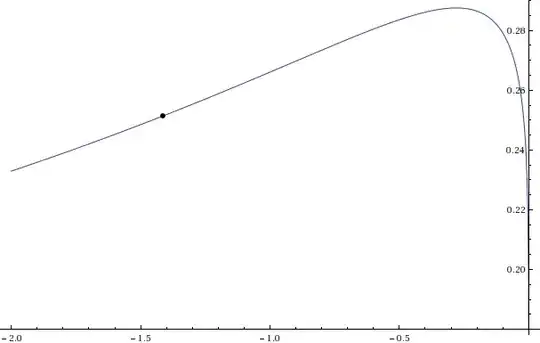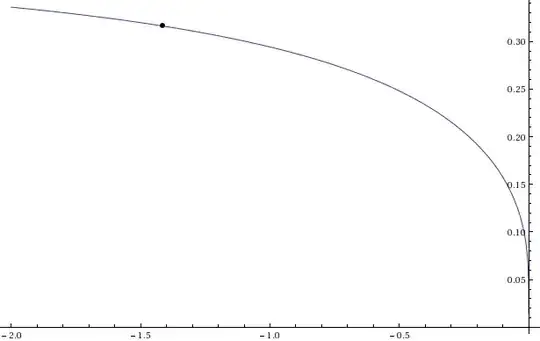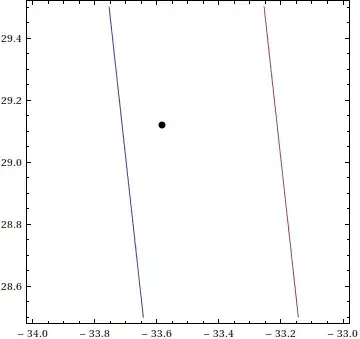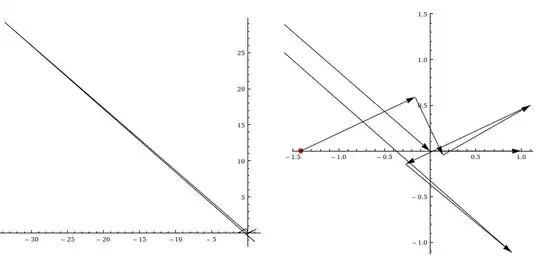Problem:
How we can strictly prove $(-\sqrt{2})^{(-\sqrt{2})^{(-\sqrt{2})^\ldots}}$ can't be 2?
Can $(-\sqrt{2})^{(-\sqrt{2})^{(-\sqrt{2})^\ldots}}$ have the value expressed by complex numbers? (See below, in calculation details), like $i^i=e^{-\frac{\pi }{2}+2k\pi} \quad (k \in \mathbb{Z})$?
Details:
In this other question of mine, Are the solutions of $x^{x^{x^{x^{\cdot^{{\cdot}^{\cdot}}}}}}=2$ correct?, I show how to find the possible solutions for $x$ in the equation. $\sqrt{2}$ is one root and this is ok, but, what about $-\sqrt{2}$? Maybe it isn't a root, but how to strictly prove this? The prove given in that question (as we can read in the comments) looks wrong, so I'm searching for a correct one.
Calculation details
This was posted in the other question (as an answer, but the truth is just a huge comment, as I explained) and I think is pertinent to here too.
" It looks like $-\sqrt{2}$ isn't a solution for the equation, but I'm not sure. Looks like too, the power tower of a number should converge only on a specific interval ($[e^{−e},e^{1/e}]$).
But using Mathematica and the ProductLog function (the Lambert $W(z)$ function) we find some strange things:
Using $h(z)=z^{z^{z^{\ldots}}}=-\frac{W(-\log (z))}{\log (z)}$ (h[z_]:=(-ProductLog[-Log[z]])/Log[z])
Calculating the power tower to $\sqrt{2}$ we have
N[h[Sqrt[2]], 10]=2.000000000
And the power tower to $-\sqrt{2}$ we have
N[h[-Sqrt[2]], 10]=0.2513502988 + 0.3162499180 I
Calculating explicity, by iteration
${-\sqrt{2}},{(-\sqrt{2})}^{({-\sqrt{2}})},{(-\sqrt{2})}^{({-\sqrt{2})}^{\ldots}}$ we have
Table[N[Re[PowerTower[-Sqrt[2], i]], 30] + I*N[Im[PowerTower[-Sqrt[2], i]], 5], {i, 1, 15}] // TableForm
-1.41421356237309504880168872421
-0.163093997943414854921937604558+0.59044 I
0.140921295793052749536215801866-0.044791 I
1.10008630700672531426983704055+0.50079 I
-0.268168781568546776692908102136-0.14235 I
0.894980750563013739735614892750-1.1090 I
-33.5835630157562847787187418023+29.118 I
6.49187847255812829134661655850*10^-46-1.5181*10^-45 I
1.00000000000000000000000000000+1.5134*10^-45 I
-1.41421356237309504880168872421-2.2930*10^-44 I
-0.163093997943414854921937604558+0.59044 I
0.140921295793052749536215801866-0.044791 I
1.10008630700672531426983704055+0.50079 I
-0.268168781568546776692908102136-0.14235 I
0.894980750563013739735614892750-1.1090 I
Plotting the real and imaginary part of the function $h$, we have:
To the real part:
Plot[Re[N[h[x]], {x, -2, 0}, Epilog -> {PointSize[0.01], Point[{-Sqrt[2], N[Re[h[-Sqrt[2]]]]}]}]

and to the imaginary part:
Plot[Im[N[h[x]], {x, -2, 0}, Epilog -> {PointSize[0.01], Point[{-Sqrt[2], N[Im[h[-Sqrt[2]]]]}]}]

So looks like the function converges, but, unfortunately not to $2$.
"


Graphics[{AbsolutePointSize[2], Line[Composition[Through, {Re, Im}] /@ Drop[NestList[((-Sqrt[2])^#) &, N[-Sqrt[2], 100], 600], 150]]}, Axes -> True, PlotRange -> {{-5/2, 5/2}, {-5/2, 5/2}}]– J. M. ain't a mathematician Dec 08 '11 at 01:55